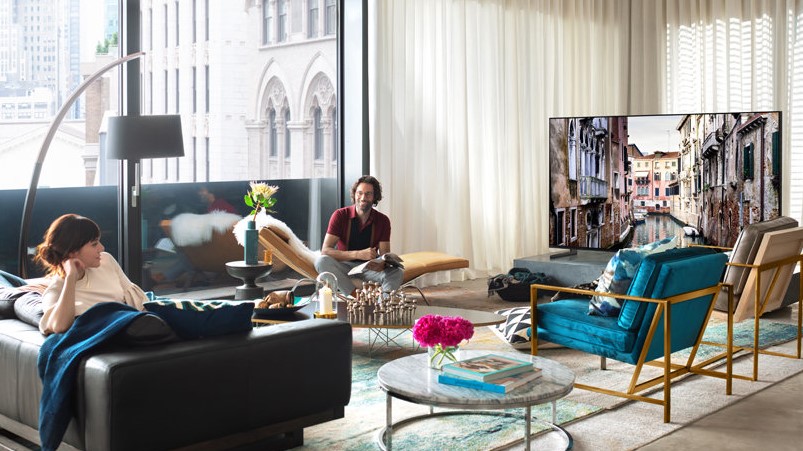TechRadar Verdict
It’s easy to be cynical about Samsung's 8K TV. With precious little native 8K content currently available or due any time soon (outside of Japan, anyway), surely an 8K TV can’t be worth buying now, right? Wrong, actually. For while the 85Q900R is indeed at its barnstorming best with native 8K images, it also sets new standards with the lower resolution images we’re already watching now…
Pros
- +
8K pictures look immense
- +
Incredible brightness and color
- +
Ground breaking upscaling
- +
Cheaper than expected
Cons
- -
85-inch screen limits market
- -
Some occasional backlight issues
- -
Some occasional color issues
- -
No Dolby Vision support
Why you can trust TechRadar
With most people - *cough* content providers - only just getting to grips with 4K resolution, you’d be forgiven for thinking that Samsung had gone nuts by introducing the world’s first true 8K TV. With hardly any native 8K content available out there, what's the point of spending big to get your hands on so many pixels?
It's because, although it doesn't feel this way, 8K content is coming sooner rather than later: Japan’s NHK broadcaster is launching an 8K channel in December, while Netflix and TV France, among others, have already filmed some stuff in 8K.
But what really makes the 85Q900R exciting as a TV for today rather than tomorrow, though, is that surprisingly it doesn’t actually need native 8K pictures to look incredible – it takes any content you feed it and spits out some of the best images we've yet to see on a screen this size.
- What is QLED? Samsung's panel tech explained
Price and release date
Whether or not the world is ready for it, the Samsung Q900R is already out in the wild. In the US, it's available in an 85-inch variant called the Samsung QN85Q900RAFXZA and, soon in a new 98-inch variant.
In the UK and other regions it's called the Samsung QE85Q900RATXXU and it's available in 65, 75 and 82-inch variants – along with a brand new 55-inch 8K QLED model announced at this year's IFA 2019.
As for the price, the Samsung QN85Q900R will set you back $14,999 in the US, which comes out to be around £11,600 or AU$21,000. As for the 98-inch version, the hefty $100,000 price tag has since dropped to $69,000 (circa £55,000 / AU$100,000). Start saving, readers.

Design
For all its astonishing, cutting-edge features, the 85Q900R isn’t really much to look at in design terms: It's just a thin dark frame wrapped around an (admittedly impressively huge) 85-inch screen with a pair of king-sized feet tucked under each bottom corner.
Sign up for breaking news, reviews, opinion, top tech deals, and more.
While those feet could present many households with a problem given the size of furniture you’ll need to rest the TV on, we didn’t actually find the 85Q900R’s lack of stlye a problem. After all, when you’re talking about a TV with an 85-inch screen and more brightness than any other TV before, its stunning pictures are really all that you see anyway.
The 85Q900R’s design minimalism is enhanced by the way it puts all of its connections onto an external ‘One Connect’ box that jacks into the TV via a single, surprisingly slender cable. The current Q900R One Connect carries four HDMI 2.0 ports, three USBs, Bluetooth (which provides your only headphone option), and support for wired and wireless networking.
We say ‘current’ One Connect for a reason, though, as Samsung is going to introduce a new One Connect box for the Q900R range in the new year that will carry an HDMI that’s built to the brand new, barely ratified HDMI 2.1 standard. This is important because HDMI 2.1 can carry much more data than HDMI 2.0, and can support 8K at 60 frames a second and more, rather than only supporting 8K at 30 frames a second as the first batch of Q900Rs do.
What’s more, Samsung is going to make these upgraded One Connect boxes available (once they’re ready) to people who buy Q900Rs now - though at the time of writing, Samsung can’t confirm the exact terms on which this upgrade will operate.
Design TL;DR: While there’s nothing very flash about the 85Q900R’s design, it’s well built, and its minimalist approach means there’s nothing to distract you from its game-changing pictures. Its external One Connect box keeps cable chaos to a bare minimum, and should receive an HDMI 2.1 upgrade at some point in the future.
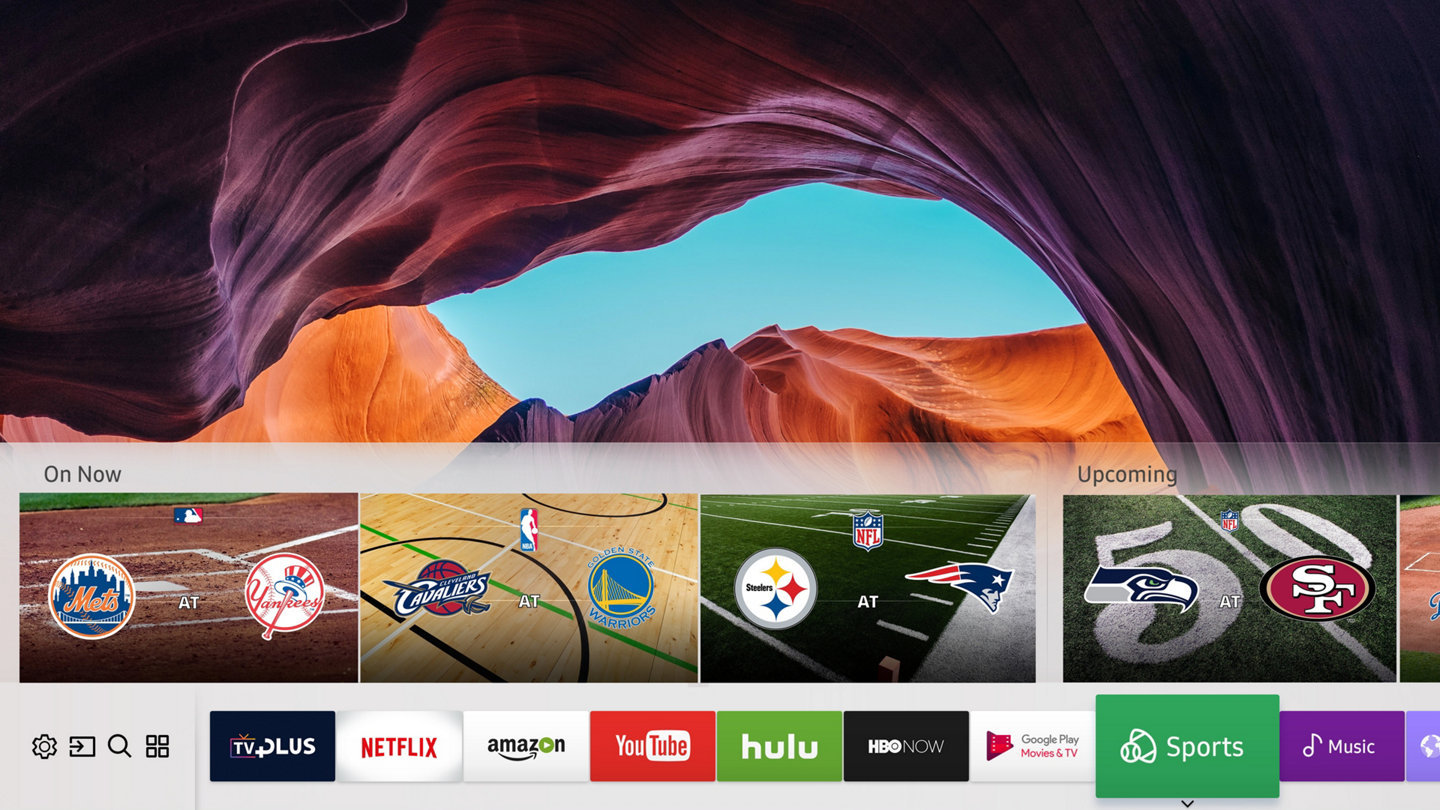
Smart TV (Eden 2.0)
Despite boasting an all new processing system, the 85Q900R carries the same ‘Eden 2.0’ smart TV system found on all of Samsung’s other mid-range and high-end TVs for 2018. That might sound bad, but actually isn't much a problem at all given that Eden 2.0 combines a huge wealth of apps with a straightforward, easily customized interface and impressive voice control/search functionality.
The key apps are all up to date in their latest versions too, meaning that Amazon Prime, Netflix and YouTube all support 4K HDR playback. Unfortunately, though, 8K videos aren't supported in any of the above ... yet.
Happily, thanks Samsung’s new processing engine, there's not even a hint of instability or slow down in the menus compared with Samsung’s flagship 4K TVs, the Samsung Q9FN QLED series, despite needing to drive twice the amount of pixels.
Smart TV Features TL;DR: Aside from the white backdrop behind its icons making the system look a touch dated, Samsung’s smart platform is one of the best the TV world has to offer right now.
HD/SDR Performance
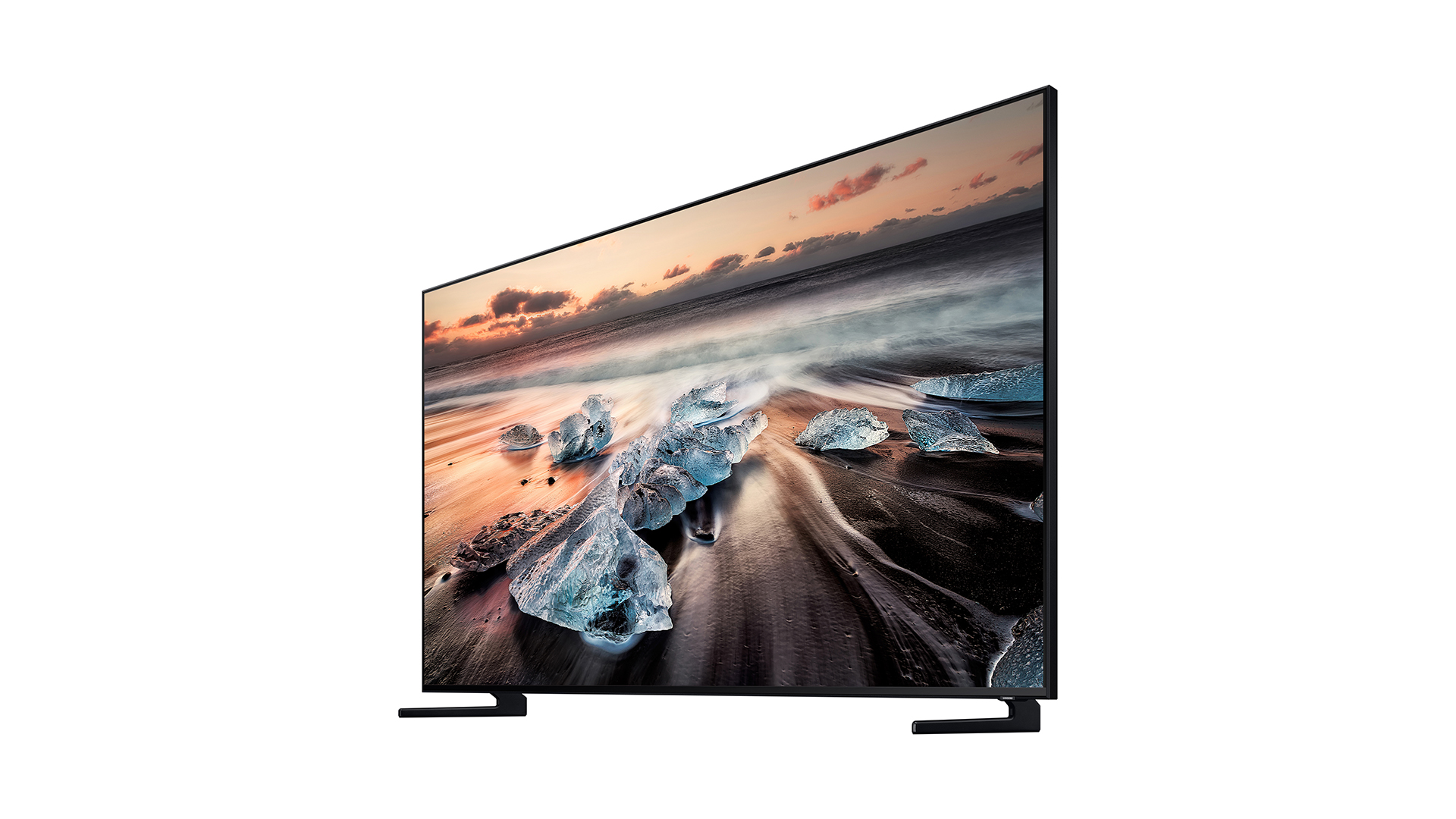
Screen sizes available: 65-inch (Europe only), 75-inch (Europe only), 82-inch (US only) and 85-inch (Europe and US) | Tuner: Freeview HD | 4K: Yes (actually 8K!!) | HDR: Yes (HDR10, HLG, HDR10+) | Panel technology: Samsung QLED | Smart TV: Yes/Eden 2.0 | Curved: No | Dimensions: 1905.2(w) x 1094.2(h) x 36.3(d) mm | 3D: No | Inputs: Four HDMIs (all 2.0 initially, with one 2.1 being added in next year’s units), three USBs, RF tuner
It seems almost perverse to kick off the performance section of this test of an 8K TV by focusing on its performance with HD and standard dynamic range content.
But, as well as this simply being the way we do things, it’s important to reflect that however exciting the thought of 8K might be, most of the video that households typically watch right now appears in HD and standard dynamic range. Which, one would expect to surely present a bit of a problem for a TV as huge, rich in resolution and ultra bright as the 85Q900R, right?
Not as much as you might expect, actually. In fact, the all-new 8K AI Upscaler Samsung has created for its new 8K TV generation does an almost miraculously good job of conjuring up the tens of millions of extra pixels needed to turn HD into 8K.
For starters, the upscaling engine does a brilliant job of separating source noise (such as compression artefacts and over-enthusiastic grain) from ‘proper’ picture information. It then calculates the look of the 30 million plus extra pixels required cleverly enough to leave HD images looking sharper, more detailed, more dense and more three dimensional than they ever have before. Even on the best 4K TVs.
The usual jaggedness around angled or arced edges is completely removed during the 8K upscale, too. Perhaps best of all, though, all of these remarkable (when you stop to think about what the TV is doing) upscaling achievements are delivered in real time without generating any of the sort of unwanted side effects commonly associated with heavy duty upscaling: there’s no double edging, no exaggerated MPEG noise, no ‘stepped’ edges, no sense of motion lag, no unwanted grittiness, no fizzing or shimmering over areas of really intense detail… The purity of the upscaled pictures truly is remarkable to see, and has our hopes up that Samsung consider porting the 85Q900R’s scaling engine over to its premium 4K TVs for 2019.

That said, there are a couple of riders we should add to the 85Q900R’s handling of HD. First, you should activate the Clean View noise reduction feature on its Low setting unless your HD source is absolutely pristine, as this does an excellent job of burnishing off the one or two rough edges the basic 8K AI Upscaler occasionally leaves (albeit at the cost of a little sharpness).
Second, we wouldn’t necessarily characterize the upscaled HD images as looking absolutely like 8K - in fact, they look more like ultra-polished 4K. That, in itself, is a remarkable achievement on a TV where we'd frankly expected the need to add so many extra pixels to result in HD pictures that look WORSE than they probably would on a good 4K TV, where the number of pixels that have to be added is considerably smaller.
Third, when it comes to handling standard dynamic range pictures, it can be a little tricky to get this 4000-nit, HDR-focused screen delivering true SDR light levels without it starting to lose shadow detail in the darkest picture areas. And it can similarly be a little tricky to take advantage of the TV’s HDR+ feature - which converts SDR to HDR - without some colors looking a bit peaky and compression noise in dark areas becoming exaggerated.
Your best bet, I’d say, is to not use HDR+, and just use the Standard preset with Eco features turned off and the backlight reduced a bit from its default position.
HD/SDR performance TL;DR: The 85Q900R’s upscaling system is simply a world beater, converting HD sources to 8K more effectively than I’d have thought possible. SDR content can look lovely too, if you’re careful how the TV is set up.

4K/HDR Performance
Our usual ‘4K/HDR’ header for this section actually isn’t sufficient for this review - after all, it’s the world’s first native 8K television. Having said that, though, aside from a tiny number of 8K YouTube videos, there’s currently no native 8K content a normal consumer can watch.
This is a huge pity, as having tested the 85Q900R with some specially shot 8K clips provided by Samsung, featuring lots of gorgeous views and shots of nature, we can safely say that native 8K looks absolutely astonishing. Any doubts over whether an 8K pixel count can look significantly better than a 4K pixel count are instantly crushed, as your eye is dazzled by 8K’s extra detail, textures, clarity, and enhanced sense of image depth.
Colors look massively more refined too, making objects look more solid and free of any and all pixel structure or ‘stepping’ around curved or diagonal edges.
The extent to which the 85Q900R’s colour performance helps to unlock the full impact of all those extra pixels joins the TV’s remarkable upscaling in illustrating just how stunning Samsung’s new 8K processing engine is.

While native 8K playback on the 85Q900R introduces a whole new level of picture quality awesomeness, crucially 4K playback looks fantastic too. The upscaling engine that surprised us so much with HD is even more effective with 4K: Resolution looks clearly higher than the native resolution of the 4K images, and again this is achieved with pretty much no unwanted upscaling side effects whatsoever.
In some ways the 85Q900R’s remarkable 4K enhancements - which add depth and color refinement, as well as the extra perceived resolution - are more important right now than its native 8K performance. After all, the fact that the set can make today’s best-quality source look significantly better than it does on mere 4K TVs means that anyone who buys one won’t have to wait until native 8K content appears to get a picture quality return on their investment.
All that said, the unprecedented range of color tones the 85Q900R can reproduce thanks to its processing and extreme brightness also reminds us more emphatically than any previous QLED TV of the importance of Samsung’s metal-clad Quantum Dot design. This enables the TV’s QDs to be driven harder than normal QDs without them suffering any performance/lifespan degradation and the 85Q900R’s brightness is as jaw-dropping as its 8K resolution. Capable of delivering well over 4,000 nits of brightness on a 10% white HDR window, Samsung’s 8K star serves up easily the most flat-out spectacular high dynamic range pictures we’ve ever seen.

Remarkably, though, despite being almost twice as bright as any previous TV, the 85Q900R doesn’t only do the bright parts of HDR’s expanded light spectrum well: Its backlight arrangement, local dimming system and powerful processing also mean that it can deliver impressively deep black tones during HDR playback. In fact, intensely dark areas of HDR pictures can look emphatically black.
Black levels tend to remain uniform and deep if a very bright object appears in the middle of a very dark area, which is can typically be a nightmare for LCD/LED TVs. This has typically been an area where rival OLED technology excels but the 85Q900R generally handles it superbly, with minimal greyness and scarcely a trace of accidental backlight ‘blooming’ around the bright area.
It should be said that the 85Q900R takes quite a bit of brightness out of very small bright highlights, to keep backlight blooming under control. For instance, a small torch light in the night looks brighter on the Q9FN or the latest OLED TVs than it does on the 85Q900R. But there’s less backlight blooming around the torch on the 85Q900R than there is on the Q9FN.
Also, with all but the smallest bright objects hits a slightly bigger size, the 85Q900R manages to make the object brighter than it looks on the Q9FN - yet again, usually, with no blooming.
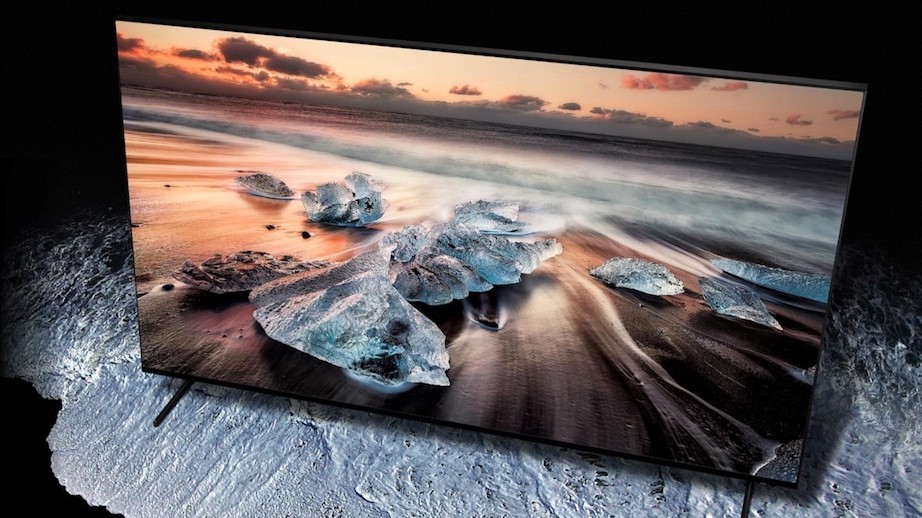
There are however, a trio of negative sides to the 85Q900R’s higher brightness. First, black levels during shots containing a broad mix of light and dark content can look greyer than they do on OLED TVs or the Q9FN.
Second, while blooming is generally brilliantly handled, it can appear faintly over quite large areas of the picture if a very dark shot contains a lot of extremely faint detail. The sort of image content that can cause this is very rare, though.
Finally, while the 85Q900R’s extreme brightness typically has a massively beneficial impact on color, with rare shots that contain a mix of light and dark content scattered right around the image, colors can look a touch faded compared with the Q9FN due to the backlight seeping a little more into image areas where it shouldn’t.
One other backlight issue finds brightness taking a fraction longer to react to sudden cuts from bright to dark shots than it ideally would, meaning you can sometimes see the light ramp down slightly after a dark shot has appeared.
The 85Q900R’s glorious pictures, though, demand that we wrap up this section on a high note, so let’s do that by saying that if you use its Game picture preset, it only suffers with less than 20ms of input lag - even when upscaling from HD to 8K. This is quite some feat.
4K/HDR Performance TL;DR: The TV’s incredible resolution and brightness combine to deliver simply the most stunning pictures I’ve ever seen on a TV. This is especially true with native 8K playback, but crucially given where the TV content world is at right now, upscaled 4K HDR pictures also look better than I’d dreamed possible.

Sound
Unfortunately, compared with its pictures, the 85Q900R’s audio is a bit of a let down. Its speakers struggle to deliver the sort of volumes such a massive TV needs to complete its cinematic experience, and the sound never really feels like it’s coming forward into the room (unlike those explosive pictures).
Voices still manage to sound intelligible and warm, though, and kudos are due, too, to Samsung’s Smart Sound system, which does a mostly good job of automatically optimizing the sound settings to whatever type of content you’re watching.
Sound TL;DR: While it’s free of distortions and features a pretty intuitive automatic sound adjustment processing option, the 85Q900R’s speakers lack the power and attack to do its massive and brilliant pictures proud.
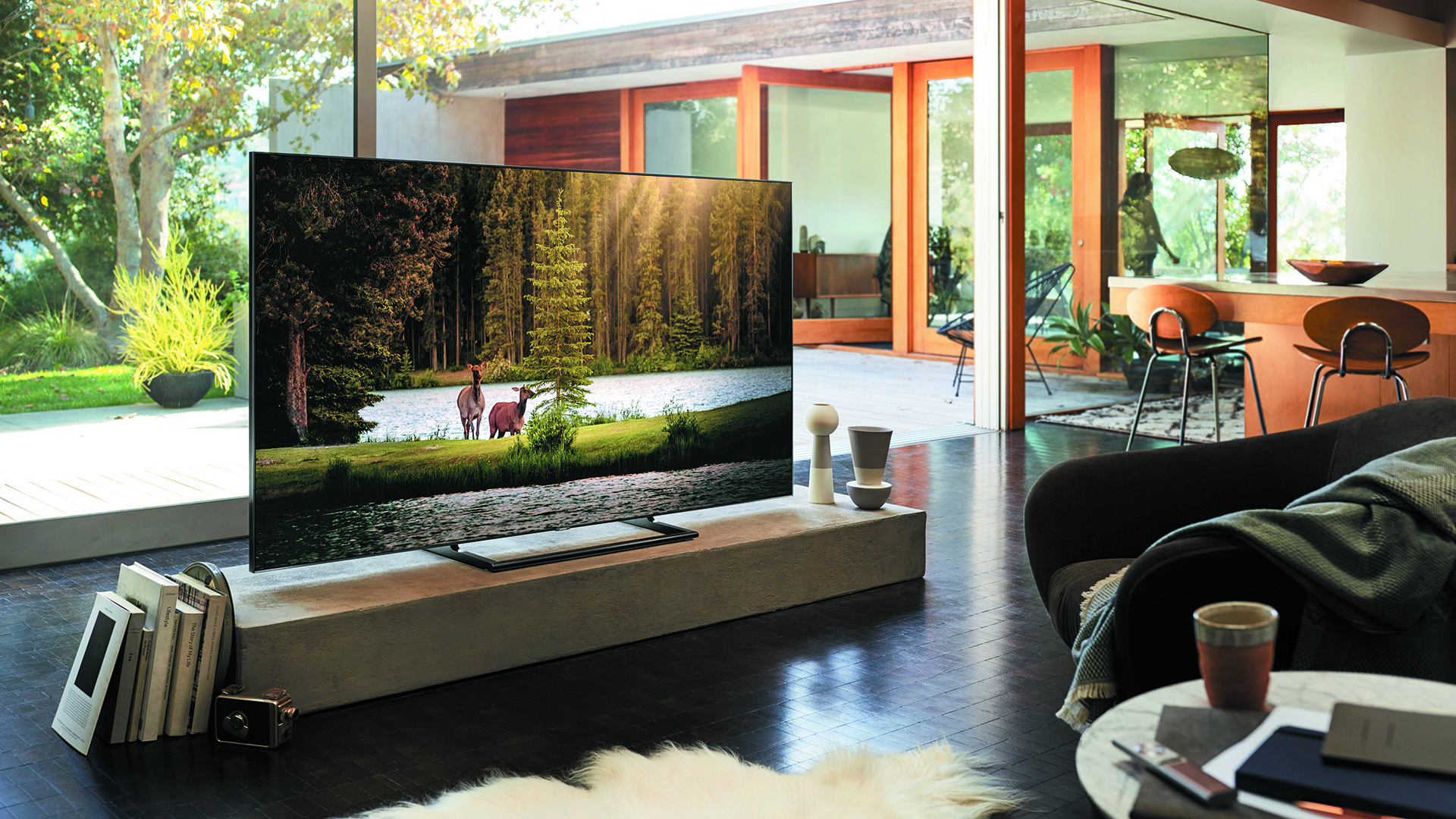
Other panels to ponder...
If you can live without the 8K future proofing, superb 4K upscaling and peerless brightness and color the 85Q900R offers, you could look at Samsung’s outstanding 4K Q9FN range instead. (Though, the biggest of these you can get is 75 inches.)
Another excellent 75-inch TV is the Sony KD-75XE9405 (called the Sony Bravia XBR-75X940E in the US). This is a 2017 model, and is nowhere near as bright as the Samsung but it’s available at knock-down prices now, and is an excellent performer within its 4K and reduced brightness ‘limitations’.
Finally, if you’d like to partner a massive screen with OLED rather than QLED technology, the LG C8 OLED can give you 77-inches of perfect black levels and rich colors - though with less sharpness and much less brightness.
Final verdict
The 85Q900R ushers in a new era of TV picture quality. Its native 8K pictures are incredible, looking just like the real world - only better. But even more crucially given the dearth of true 8K content for the foreseeable future, the 85Q900R makes all today’s lower resolution sources look better than they do anywhere else, too.
Whether 8K delivers the same impact on smaller screens remains to be seen, but if you have a big enough room and budget, the 85Q900R is a vision of the future that’s actually spectacularly worth buying today.
- Looking for a cinema-sized screen? Here are the best 75-inch 4K TVs
- Or just the best Samsung TVs you can buy right now
- Get the best deal on Samsung products with our Samsung coupon codes.

John has been writing about home entertainment technology for more than two decades - an especially impressive feat considering he still claims to only be 35 years old (yeah, right). In that time he’s reviewed hundreds if not thousands of TVs, projectors and speakers, and spent frankly far too long sitting by himself in a dark room.
